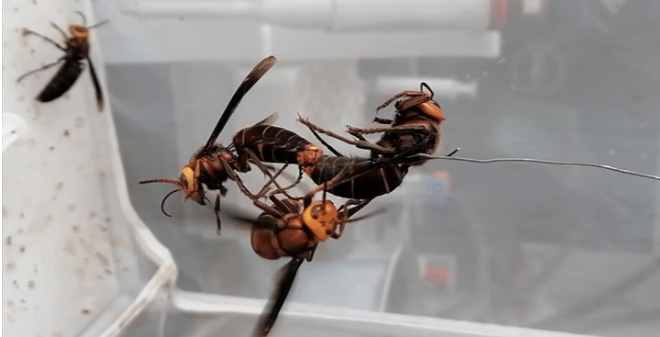||| FROM GIZMODO.COM.AU |||
Birds do it, bees do it — even the wasps that kill bees do it. A clever team of scientists now has an idea to use the Asian giant hornets’ horniness against them, in hopes of stopping the invasive species from decimating U.S. bee populations. They’ve identified the sex pheromones of the queen and propose trapping the hornet drones that are lured in by the pheromones.
The Asian giant hornet (Vespa mandarinia) preys on bees, and its stings are pretty painful to humans (they can kill people who are allergic to their venom). The hornets are native to Asia but have recently spread into the U.S.; they were first caught in Washington State in August 2020, and since then, they’ve spread across the American northwest. This invasion is worrying, since the hornets can slaughter a honeybee hive in a matter of hours.
Recently, a team of entomologists caught a bunch of virgin giant hornet queens and their drones from colonies in Yunnan, China. They swabbed the queens’ sex glands and used gas chromatography-mass spectrometry to identify pheromone compounds from six of the queens. The team’s findings were published today in Current Biology.
“We were able to isolate the major components of the female sex pheromone, a odor blend that is highly attractive to males who compete to mate with virgin queens,” said James Nieh, an entomologist at the University of California at San Diego and co-author of the recent paper, in an email to Gizmodo. “When these components or their blend was tested in sticky traps, they captured thousands of males.”
“Such traps are also usually highly specific, as we found in our study,” Nieh added. “We did not capture any other insects or even female giant hornets. This reduces their ecological impact.”
Asian giant hornets are the world’s largest hornet species, measuring up to 2 inches long (about as long as your thumb) with a 3-inch wingspan. Their abdomens are striped orange and black. So far, their spread in North America is limited to British Columbia and Washington State, but researchers fear the insects will continue to spread without swift action to stop them. Currently, entomologists try to manage the hornet population by manually removing their nests. But finding the nests is difficult, and using pheromone traps would mean that the insects would head to their own executions.
The hornets notoriously decapitate bees and then carry their thoraxes home as food for larvae. When under attack, the bees make a sound that researchers believe is akin to screaming.
Honeybees do have some defences to the hornets. By huddling together and “shimmering” in specific patterns, the bees can confuse hornets seeking to attack any individual bee. Bees also smear the entrance to their hives with animal poop as a deterrence, and some unfortunate hornets even get cooked alive by bees that vibrate around them, generating temperatures hot enough to kill the invaders.
**If you are reading theOrcasonian for free, thank your fellow islanders. If you would like to support theOrcasonian CLICK HERE to set your modestly-priced, voluntary subscription. Otherwise, no worries; we’re happy to share with you.**








